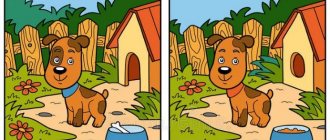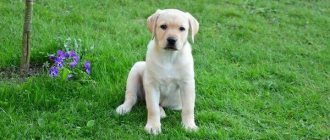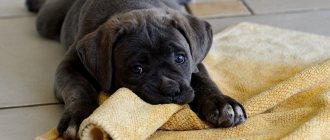At what age do you start training?
Puppy training must begin from the very first days
the presence of a dog in your home. Because already from infancy, the puppy must learn the rules of behavior in your house, what is allowed and what is forbidden, how to behave with all family members, even the smallest and oldest, what he can play with and what he can’t, where to go. toilet and much more.
And we are talking, first of all, about the proper upbringing of a beagle puppy, and you can start training and learning commands when the puppy is completely comfortable in your home. As a rule, one week is enough. By this time, the puppy is already filled with curiosity and is diligently exploring the world around him. If, after this time, the puppy remains fearful and does not make contact well, then it is better to seek help from a dog handler-animal psychologist, because This behavior is not typical for puppies of this breed.
When can you start training with a dog handler?
The beginning of the puppy's training coincides with the time of the first exit to the street. When the first two vaccinations have already been done, the quarantine (lasts 7-14 days, depending on the vaccination) after them is over. It is not at all necessary to train your puppy only outside; the first sessions are best done at home, where there are fewer distractions.
Often new puppy owners worry that training from the first days will be excessively stressful for the dog. This is only possible if outdated, rigid methods are used, and with the right approach, training from the first days will, on the contrary, be very useful, since it allows you to immediately establish contact
with the puppy and build a trusting relationship.
You can start raising a puppy from the first days of its appearance in your home, and training and classes with a dog handler can begin simultaneously with the start of walks, when quarantine ends after the second vaccination.
Why you don't need to wait up to 6 months
You often hear that beagles, like other dogs, cannot be trained before 6 months, because training is stressful. This opinion remains from the times of outdated methods based on cruel coercion and intimidation of the dog. Unfortunately, there are still plenty of dog handlers using similar techniques today. But fortunately, science does not stand still and modern techniques make it possible to train a puppy from the first days in a new home. Therefore, you should not wait until your beagle puppy has established unwanted behavior; you can start training much earlier.
Beagle: keeping in an apartment
From the very beginning, the breed was bred for hunting purposes, but many dogs settled in apartment buildings.
They need to ensure activity and regular physical activity, and pay attention. To say whether it is possible to keep beagles in an apartment, you need to understand the positive aspects of keeping dogs in a small room:
- friendly to other people, welcome strangers if they offer food;
- they don’t bark even if the neighbor’s door opens;
- get along well with other pets;
- can work as a free nanny and will not harm the baby;
- attached to the owner;
- most beagles are neat and clean;
- have virtually no unpleasant odor;
- dogs do not slobber on furniture and surrounding objects.
If you raise a small dog correctly, there will be no problems with him. In order for your baby to behave friendly, you need to not miss the time of socialization.
Setting up your dog's personal space
The Beagle is ideal as a first pet for a person with a strong character, since he is unpretentious in his choice of food and is easy to care for. In order for both parties to live comfortably, the dog should be given a separate corner where he can sleep comfortably or relax during the day. For a couch, choose a bright corner in the living room, but always far from a radiator or draft. In this place they place a house or a lounger that is suitable in size, and purchase a comfortable mattress with a removable cover, which can be easily washed when soiled with feces or dirt.
Beagles have a hard time getting used to one place to rest, as the active dog rushes around the apartment, falling asleep where its charge runs out. If the baby chooses a place to sleep on his own, it is better to place the lounger there. It is strictly forbidden to allow him to sleep in a person's bed or on the sofa, as the puppy will live there forever.
Accustoming to neatness
The hunting breed is smart, so it is easy to train if it receives a treat for the process. If the owner does not give the treat, then the dog becomes “stupid” because he is lazy. If children are running nearby, the dog will switch to them and forget about training.
The baby should be raised the day he gets into the apartment, and at 3-6 months he can learn prohibitions and permissions, learns neatness, hygiene, and no longer chews clothes and shoes. Training is carried out in a stern, firm voice, without shouting or swearing, because the baby can be stubborn. Before six months, you need to accustom the puppy to the fact that the owner is a king, all of whose commands must be followed.
Raising beagles is difficult, so the general training course can be entrusted to a professional. To interest the baby, he needs to be trained in a playful way for 15-20 minutes during the day. For success, the pet is given encouragement, but not chocolate, sugar or salty food. Be sure to accustom the dog to a tray, a bed, prohibiting commands, and giving paws to wash them after a walk.
Caring for your beagle will be better if you toilet train him in time. This is not difficult to do if you have patience and time, as well as observation. If your pet starts running and sniffing corners, it warns you about the need to go to the toilet. At this moment, you need to quickly transfer it to the tray and hold it until it does its “toilet” business.
How to teach a dog to stay home alone
Caring for and maintaining a beagle is a difficult task, but those who love animals can cope with it. The baby has a hard time enduring loneliness; at this time he begins to howl or chew on things. To prevent the puppy from suffering, he is not left alone for more than 10-20 minutes. Before leaving, they play with the pet, wait for it to fall asleep while the owner has left the house. The baby can harm himself independently, so he should be placed in a comfortable enclosure.
Medicines, food, electronics, gadgets should be hidden in locked cabinets so that the dog does not get poisoned. All wires are put away in cable ducts, and the balcony, which is not glazed, is securely locked. If the dog is not walked on time for three hours during the day, he will not go to the toilet and will not release his energy. A dog that does not run or play active games with its owner can destroy the entire apartment.
Training at 2 months. Upbringing
At 2 months old, your beagle puppy is still at home, in quarantine after the first vaccinations, and he is still not allowed to go for walks. Therefore, it’s time to start raising a puppy in the home conditions that are already familiar to him.
Toilet training
The first step is teaching the puppy to go to the toilet in a diaper . You should not rush to teach going to the toilet directly outside, bypassing this stage, because puppies are not physiologically ready for walking twice a day. Beagle puppies develop this ability no earlier than 6 months, and in some up to 1 year.
It should be remembered that any learning is a rather complex thing and, seeing the first positive results, you should not think that your puppy has already understood everything, but you should continue training according to the method, so that after a while you do not have to start all over again.
Collar and leash training
The second important point will be to accustom the puppy to a collar and leash . Yes, yes, this should be done at home, so that by the time the puppy goes outside for the first time, wearing a collar will not be additional stress for him, but is already a familiar thing, and he can start exploring the world around him, rather than trying to get rid of an unknown object.
What to allow a puppy and what not
The third point, which causes the greatest difficulty for new puppy owners, will be determining the puppy’s boundaries of what is permitted. Often, many novice dog owners think that the unwanted behavior of a beagle puppy will “go away on its own, outgrow it.” But, unfortunately, the behavior that is allowed for a puppy will be taken for granted later by an adult dog.
.
Any unwanted behavior in a puppy WILL NOT go away on its own, but will only become stronger over time.
Therefore, it is necessary to start defining the puppy’s boundaries of what is permitted now. You will need:
- Teach to play only with your toys, and not with your things;
- Explain that you cannot bite your hands even in a game;
- Establish the correct daily routine, establishing the rule that in the morning you need to sleep and not wake you up;
- Stop chewing furniture, clothes, walls and baseboards;
- Teach to stay home alone, knowing that your absence is not a reason to bark or howl.
IT IS EXTREMELY IMPORTANT TO KNOW: constant and excessive punishments that follow almost every action of the puppy have a detrimental effect on his fragile psyche and can lead to the fact that the beagle puppy grows up cowardly and embittered. For normal natural development, a puppy must have the opportunity to explore the world around him, which is currently limited to your apartment or house.
Introduction to Basic Commands
Already now you should begin to familiarize yourself with the initial obedience commands in a light playful form, while focusing on rewards for execution, because the puppy’s psyche is still quite plastic and excessive severity and exactingness can lead to the puppy being intimidated and cowardly. Therefore, it is necessary, first of all, to try to interest the puppy by offering him a toy or treat, and sometimes just praise.
What should a puppy know before 5 months?
At 5 months, the dog is still a puppy, but it is a kind of transitional age, like in humans. If the puppy is not taught certain rules before the age of 5 months, it will cause a lot of trouble in the future. So, what should a beagle be able to do at 5 months?
- Stay home alone . Not every dog can do this; in many ways, the reaction to loneliness depends on the breed, and not just on the dog’s personal qualities. But beagles are quite normal about such freedom. Therefore, the task is quite feasible. The training is very simple. It is necessary for the whole family to leave the house for 5-10 minutes. After a while, you need to repeat the procedure, gradually increasing the period of time so that the dog gradually gets used to the idea of short-term loneliness. There is no need to go far; on the contrary, the owners must control the dog’s behavior. But you cannot succumb to your pet’s provocation. Let him whine and bark, that's normal.
- Cleanliness is an important aspect of education. The beagle will play mischief if you do not explain to him what is allowed and what is not. But, as mentioned above, the rules of behavior at home should always be the same.
- A five-month-old puppy should not bite anything, especially the hands of the owner or any family member. Only toys should be used for games, and the animal should be punished for any indiscretion. There is no need to use force or shouting as punishment, just turn around and walk away and ignore the animal for a while. If this does not help, you can spank your pet with a rolled-up newspaper, but not with your hand, otherwise the puppy will be afraid of them!
Training at 3 months. Socialization
Three months is an important stage in a beagle puppy’s introduction to the outside world. Your first walks should be short and not too tiring for the puppy. You should start with 15 minutes, gradually increasing the walking time to 1 hour.
Correct formation of the nervous system
At this age, the puppy’s nervous system is forming.
. It has been proven that raising puppies in isolation during this important period contributed to the development of pronounced cowardice in them later. It is necessary to show the puppy as much as possible: noisy streets, large crowds of people, etc. Everything that he will have to face in later life.
This must be done very carefully, gradually, over and over again increasing the time spent in noisy places, so as not to overload the puppy or frighten him.
The territory of a country house, cottage or village are places with a minimum amount of external stimuli for a city dog. Therefore, if you plan to keep a dog in an urban environment, “growing up” a beagle puppy in such conditions depleted of irritants is unacceptable.
A city puppy must grow up in the city, in conditions that are saturated with external stimuli, such as: noisy streets, large crowds of people, other animals, birds, cyclists, cars, etc.
Meeting people and dogs
It is necessary to introduce the puppy to friendly dogs and people
so that later the puppy does not develop aggression or cowardice caused by the fear of new things and the inability to communicate and make new acquaintances. Currently, unfortunately, this is not uncommon in the behavior of adult dogs, but a fairly common problem with which people turn to our specialists for help.
Puppy behavior on the street
The emergence of new places leads to new rules that need to be consolidated:
- Now you can and should go to the toilet on the street, and not stoically endure it, carrying everything home;
- Not every new person or dog wants to communicate, so you don’t need to run headlong to meet everyone;
- Not all food is healthy, so it should only be taken from the owner’s hands.
Training and practicing commands
Training a puppy follows the same principles as at 2 months. It should be remembered that at this age puppies develop conditioned reflexes quite easily, but they are forgotten just as quickly, so you should not scold the puppy for not following commands, especially if they have not been repeated for a long time, but you should pay more attention to learning new things and repeating already covered material .
Training rules
The Beagle is a cunning but intelligent dog, so it is able to instantly remember new commands. If you properly organize the training process, the dog will learn to perform the most difficult tricks. This is a breed that forgets commands unless they are repeated repeatedly.
Raising and training a beagle is consistent: it is forbidden to teach a dog a new command until he has mastered the previous one. It is imperative to get the pet to unquestioningly follow the command so that it does not stop obeying the owner. It is necessary to remember that the dog is curious; it can be distracted by noise, smell or a stranger. Training will only be beneficial if the dog is concentrated and calm.
Definition of a leader
If a person has learned almost everything about the breed and raising a beagle, he knows that without authority it will not be possible to train a dog. The thing is that this is a hunting dog that is used to feeling like a leader in any situation. If the pet does not perceive the owner as a leader, he:
- refuses to obey him;
- will constantly leave the training area;
- will begin to bite, growl menacingly or scratch.
If a beagle considers himself a leader, he needs to be convinced with the help of encouragement, demandingness, and fortitude. The calmness and persistence of the owner when repeating the same command will force the dog to recognize him as a teacher and even a leader. This process will go much faster if your pet is motivated by his favorite food.
Training frequency
A long-known rule says that you should work with a puppy for as long as his attention is retained. A Beagle baby can only exercise for 20 minutes twice a day. An adult animal maintains attention for half an hour during the day, but can be distracted by external stimuli.
Tone, reward and punishment
When training your pet, you should use rewards rather than punishment more often. If you hit a beagle just once, it will stop trusting its owner and following his commands. To show that the trainer is dissatisfied with the pet, you need to start ignoring him or scolding him loudly and sternly.
Photo from Instagram account _peets.life_
A well-mannered dog will be rewarded with praise, toys and treats. If a person does not want to spend money on buying treats, they are replaced with pieces of beef, chicken, veal, turkey, and dry food.
Training at 4 - 5 months
By this time, the beagle puppy has already become accustomed to your home and usual walking areas, and no longer needs your support and care so much. He begins to flirt with other dogs, pretend that he does not hear you when you call him, and show a certain persistence and disobedience when performing various commands.
This means it's time to move on to full training . In classes at this age you can already be persistent and demanding. At the same time, the most important thing is not to overdo it, remember that classes should bring joy to both you and your dog, and only then you can achieve the desired result.
Required commands in 4 months
What commands are practiced by a beagle puppy at 4 months:
- Calm movement next
to the owner with and without a leash, with landing when stopping, with a change in pace and direction of movement - Return to you
upon request - Staying
in a free or certain position (sitting, lying, standing) for a long time: if necessary, wait for the owner on the street, when visiting a store or other establishment - Indifferent attitude towards treats scattered on the ground
- Inhibitory command
to stop unwanted actions - Execution of a set of commands “sit”, “lie down”, “stand”
at a distance and near the leg, when giving commands by voice and gestures - Stop barking
on demand.
Teaching beagle commands
A Beagle whose training includes learning basic commands must have sufficient trust in its owner when training begins. Training will strengthen obedience and further develop the animal’s attachment to humans.
The puppy develops a strong bond with its owner
Teaching the command “Come to me!”
This is one of the easiest steps in training a beagle. It is enough to repeat the command itself often when the dog approaches the owner, and reward him after he has approached. The actions are repeated many times until the puppy gets used to this bundle. You can also use treats as bait. The owner’s mood and voice should be friendly, otherwise the baby may decide that the phrase “Come to me!” is a prohibition or punishment.
Teaching the command “Sit!”
After the dog has learned to approach the owner when called, you can move on to the next command. To do this, place a brush with a tasty piece behind the beagle’s head and say: “ Sit!” Usually the puppy sits down, watching the palm with the treat. This is quite enough to encourage the baby. Then the action is repeated.
If the dog does not sit down right away, you need to gently press on the dog’s rump with your free hand, and then praise and give a treat. In any case, the voice should be calm and the words clear.
Important! You should practice following a command both at home and on the street, gradually reducing encouragement to verbal praise.
Teaching the command “Place!”
This team is training after the previous one. When the puppy sits down, they say to him: “Place!” In this case, you should extend your hand in front of you. The goal is to train the beagle to stay in the same place for at least some time. After completing the order correctly, the dog is rewarded. The training continues until the dog learns that it should stay where it was left and not follow its owner.
Training from 6 months
At this age, the puppy begins puberty and the real rebel awakens in him. He begins to re-test the boundaries of what is permitted and, sometimes, deliberately does not respond to your commands, only in order to look at your reaction. If she is not what the puppy expects to see, then he may decide that now he can no longer carry out your commands.
Remember that a puppy is still a child.
, and excessive harshness can forever undermine his trust in you.
At this stage of the beagle puppy's growing up in training, all the shortcomings made at the previous stages, which were smoothed out by his young age, become clearly visible. And if they appear, it’s time to correct them.
In many training schools, there is an opinion that a puppy needs to be trained in two stages, the first at an early age, and the second at 8 - 10 months, in order to “consolidate” what has been learned. This is not an entirely correct position; this opinion appeared when newer operant training methods began to be added to the old “DOSAAF” rigid training methods, where they began to work with the puppy strictly after 6-7 months, including working with the method of pointing and following the “target”.
Their weakness was that they were two different techniques.
, which began to be used without adapting to each other, having a huge gap between their tools for developing training skills. The difference between them is like between choreography lessons in kindergarten and army drill training. Therefore, they required training in two stages, which were in no way connected with each other.
Modern methods based on zoopsychology make it possible to train a puppy in a single system , when no additional stages of training are required.
Eliminate Beagle's 20 bad habits in 10 DAYS!
Hello, dear Owner
Beagle.
My name is Vladimir Volkov. I want to share with you my successful experience in Beagle training.
Are you having problems with your Beagle puppy?
Do you want to stop your puppy's habits of biting, chewing and disobeying?
Are you tired of aimlessly searching for information on Beagle training methods without getting results?
Many owners ignore these warning signs and are later forced to deal with an unruly, aggressive, and dominant dog.
Don't become one of these owners!
I recommend: Rules for training and raising huskies
I urge you to please continue reading. I'm going to reveal to you the most effective proven training formula to put an end to your Beagle's behavior problems with a simple guide.
Sincerely,
11 months ago I was having serious problems with my 10 week old Beagle puppy. Not only did he destroy everything in the house, he also bit and chewed on everything he could get his hands on. Just 6 months after I got Silver, he:
. And many other problems: strong bites, jumping on the table, and even eating harmful objects such as soap! (the treatment was very expensive)
Our dog handlers
beagle training specialists
Alexander Chaplygin Dog psychologist-zoopsychologist
Experience: 37 years Read more..
Ekaterina Panova Dog psychologist-zoopsychologist
Experience: 34 years Read more..
Yaroslav Morozov Dog psychologist-zoopsychologist
Experience: 25 years Read more..
Lada Yurtseva Dog psychologist-zoopsychologist
Experience: 21 years Read more..
Victoria Fox Dog psychologist-animal psychologist
Experience: 14 years Read more..
Ekaterina Budkina Dog psychologist-zoopsychologist
Experience: 13 years Read more..
Evgeniy Bravinsky Dog psychologist-zoopsychologist
Experience: 17 years Read more..
Vitalia Bravinskaya Dog psychologist-zoopsychologist
Experience: 10 years Read more..
Kira Ageeva Dog psychologist-zoopsychologist
Experience: 19 years Read more..
Evgenia Zuber Dog psychologist-zoopsychologist
Experience: 12 years Read more..
Tatyana Melnikova Dog psychologist-zoopsychologist
Experience: 10 years Read more..
Alexey Melikhov Dog psychologist-zoopsychologist
Experience: 22 years Read more..
* Check with the managers for the possibility of a specific specialist visiting the area you specified. If the desired dog handler does not work in your area, then we can offer you another specialist from the above.
Beagle puppy training
When you turn to our dog training center for help in training a beagle puppy, you can be sure that a real specialist in his field
and will provide training at the proper, highest level.
- A dog trainer will come to your
home at a time convenient for you. - Classes are held 1-2 times a week
, depending on the program. - Instructors work from 9:00 to 21:00
, on weekends inclusive - The training program is drawn up at the first lesson,
taking into account the breed, age, personal characteristics of the dog and your wishes for training - Some classes take place at home
, some
outside
, depending on the topic of the lesson. - Puppy age
from 2 months
Our Center employs dog handlers - animal psychologists who have experience in working with beagle puppies and training adult dogs from 10 to 35 years old, who know all the nuances of their behavior
and features of training at each stage of a dog’s growth. Therefore, your pet is guaranteed to learn to carry out your commands the first time in any conditions, and will become your faithful and reliable companion.
Beagle behavior correction
Our specialists will help you correct any unwanted behavior of your dog, be it aggression, cowardice, destructive behavior and more. We have specialists for each correction profile.
Any behavior of a dog has its own reasons, and often a whole complex of reasons, only by eliminating which can the desired result be achieved. During classes, the dog handler conducts various behavioral tests to identify the causes, and based on their results, creates a program for correcting behavior.
Aggressive behavior
Types of aggression we work with:
- to you and your family members
- to your newborn baby
- To your children
- To the children on the street
- To your other dog
- To the dogs on the street
- To your guests and people on the street
- Cowardly-aggressive reaction
- Biting hands and feet during play
- Other types of aggression.
Aggressive behavior is a fairly common phenomenon, fortunately it is correctable. There are a huge number of reasons for this behavior and each type has a separate correction method. There is only one general rule: aggressive behavior will not go away on its own.
, the dog will not “outgrow” it, and as a rule, over time it can only get worse. Therefore, we strongly recommend that you begin to correct aggressive behavior as soon as it appears. Our specialist will help you identify the causes of aggressive behavior and eliminate it as soon as possible.
Cowardice
We very often have to deal with various fears in our clients' dogs. There are many fears, but for the most part there are only four reasons: Early sensory and social deprivation, difficult fate (mainly in dogs from shelters), improper upbringing and, less commonly, genetic abnormalities. Working to overcome fears is painstaking work that does not tolerate mistakes or negligence. Our specialists will help your dog overcome its fears and start living a full life.
Common fears we work with:
- Fear of loud noises
- Of people
- Dogs
- Busy street
- Elevators, stairs, entrances
- Other fears.
Howling and barking in your absence
Often left alone all day, a dog begins to howl or bark; there are many reasons for this. At the same time, classical “Pavlovian” training is powerless here, since it implies interaction with the dog at the moment the action is performed or almost immediately after. Here animal psychology comes to the rescue, which allows you to work with a dog not as a soulless mechanism, but as a person. Helps identify and eliminate the causes of such behavior. Our animal psychologists have the appropriate qualifications and easily solve such problems that are beyond the capabilities of most other dog handlers.
Picking up from the ground
This problem has become very relevant lately, due to the increasing frequency of deliberate baiting of dogs.
It is extremely important to teach your dog not to pick up anything on the street, since even with the most favorable outcome, such behavior threatens permanent illnesses, allergies and digestive system disorders. By contacting our center, you can be sure that after training your dog will no longer pick up anything on the street.
Destructive behavior
We often have to deal with the fact that during the absence of their owners, and sometimes even in their presence, some dogs chew various things that are not intended for this: shoes, furniture, clothes, wires and even walls. Many people think that this is an age-related problem and that it will go away with time, but as practice shows, the dog grows up, but the problem remains. Our specialists will help you determine the cause and eliminate this behavior using modern methods of training and correction.
Toilet training
This problem is often faced not only by owners of puppies, but also of adult dogs. If in the case of puppies, the reason often lies in a lack of understanding of where to go to the toilet, then owners of adult dogs often notice that their dog does this quite deliberately. Our animal psychologists will help you understand the reasons and correct this behavior, regardless of the dog’s age.
Call a dog handler to your home











